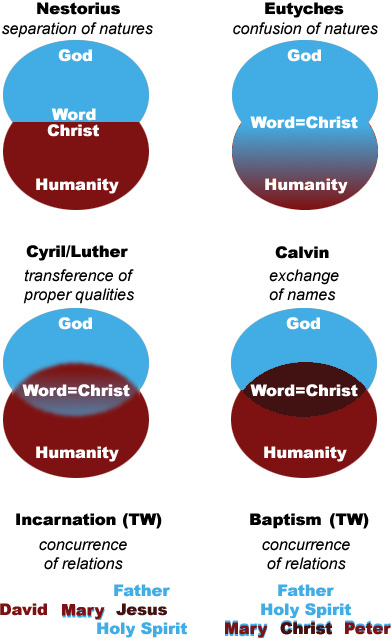
Growing in Favor with God: Salvation as Jesus' Personal History
How Is Jesus Both Divine and Human?
Jesus instantiates/expresses the fullness of humanity in both unparalleled and typical ways (Rom. 5, 1 Cor. 15)
Jesus instantiates/expresses the fullness of divinity in ways that both distinguish and unite him with his Father and his Spirit (Col. 1)
"We believe in one Lord, Jesus Christ" (Nicea): neither instance violates the other
Problem: How do the two relate?
Solution: Chalcedon affirms their unity in Jesus' person (hypostasis), confessing Jesus as
perfect both in deity (theotêti) and in humanity (anthrôpotêti) … truly God and truly human … of the same substance with God (homoousion tô patri) with respect to his divinity, and of the same substance with ours (homoousion hêmin) with respect to his humanity. … We know this one and only Christ – Son, Lord, only-begotten – in two natures (duo physesin).
A Chalcedonian Legacy: Essence Subordinates Personhood
Since the patristic era, all agree that personhood
(1) instantiates and thus expresses essence
(2) fully and indivisibly
(3) constituting and distinguishing subjects relationally
A Chalcedonian axiom: There can be no full yet impersonal expression of a nature
Both extremes of fifth century Christology tended to equate substance and personhood
(so Cyril's "one divine nature of the incarnate logos", Nestorians' dual personhood, Eutyches' denial of human consubstantiality)
Chalcedon rejects these stable opposites: Jesus' single personhood is the location of henosis (unifying) of two abstracted natures
The debate centers on substance rather than personhood, determining the character of henosis
Chalcedon achieves much, but opens lasting schisms and continuing dissatisfaction and fails to prevent new heresies
What Does Henosis Achieve?
Communication of Attributes (Cyril, Luther): qualities proper to each nature transfer to the other nature
Effects: Immanence; divine humanity (and human divinity?); real presence
Exchange of Names (Calvin): natures remain distinct but 'interact' by synecdoche
Effects: Transcendence; forensic justification; spiritual presence
Concurrence of Relations (TW): Jesus brings divine relationships and human relationships into perfect communion
Jesus enjoys both divine and human relationships with
God (sonship, obedience),
human beings (lordship, brotherhood), and
all creation (lordship, stewardship)
As personal relationships, these constitute Jesus as such (John 14:26, 15:26; Rev. 5:5; Col. 1:15, 1:18)
In Christ, "God-with-us," divine and human persons open up to each other without reserve
Unity of divine and human relations is constitutive only of Jesus, but all divine and human persons benefit
Effects: Intimacy? inheritance? relational presence? (damnation as isolation/relational distance?)
Does Henosis Have a Longer Story?
An ancient problem: How should orthodoxy narrate the apparent changes in Jesus' relationships?
(e.g., human growth, transformation at baptism, crucifixion, resurrection)
Adoptionism: Jesus' divinity is conferred in the course of narrative events (cf. Acts 2:36, 10:36-38)
Classical Christology: Narrative events merely reveal Jesus' prior divinity (cf. Acts 2:11)
Spirit-Christology: Real changes characterize Jesus' life (cf. Luke 4:1, 4:14)
A false problem: Cyrillian/Lutheran and Calvinist categories, while orthodox, tend to obscure Trinitarian and narrative distinctions
"Chalcedonian unitarianism" fails to locate the Father and Holy Spirit in Jesus' narrative
My proposal: Orthodoxy can narrate the changes in terms of Jesus' personal relationships
The divine relationships among Jesus, Father, and the Holy Spirit remain unchanged throughout Jesus' career
However, the human relationships change (Luke 2:52, cf. 3:1ff)
Case Study: Jesus' Baptism as "Growing in Favor with God"
Chalcedonian assumption: Incarnation is (or at least coincides with) anointing/inspiration (Cyril)
Is this assumption sufficiently trinitarian and incarnational?
Baptism, not incarnation (cf. Cyril), is Jesus' anointing (cf. Calvin, Comm. on Matt. 3:16)
John's baptism is Jesus' self-sacrifice to the Father, acceptance, and consequent divine empowering with the Spirit
Jesus shares his new relationships (cf. Acts 8:14-17): his christening opens the way for others' anointing at Pentecost
Conclusion: Salvation as Jesus' Personal History
All narrative turning points (transfiguration, crucifixion, resurrection, ascension, session, return) lend themselves to this analysis
The narrative shape of Jesus' concurrent relations grounds salvation-history as the ongoing wedding of God and humanity
